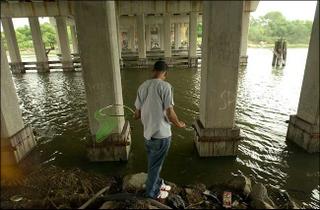It was the lure of the blue claws that attracted Alberto Cruz, 17, of East New York, Brooklyn, to the spot, where Fountain Avenue hooks underneath the parkway in the Spring Creek area of Brooklyn. Witnesses and relatives said that Alberto had recently become excited about the spot's great crabbing but was unaware of another aspect of equal renown: its mucky bottom sucks in feet like quicksand. Alberto was crabbing with a friend when he apparently tried wading to the center of the bridge, a deeper area where the crabs are more plentiful. He became hopelessly stuck in the mud, and, a weak swimmer, was unable to
 free himself or to grasp the wire crab trap that a friend tried throwing to him. Alberto went under and spent at least 20 minutes on the murky bottom until he was pulled out by police divers. He remains unresponsive and in critical condition.
free himself or to grasp the wire crab trap that a friend tried throwing to him. Alberto went under and spent at least 20 minutes on the murky bottom until he was pulled out by police divers. He remains unresponsive and in critical condition."The kid had no experience here; that's what it was," said David Morales, 48, a regular crabber. "Everyone here knows this mud. The more you move, the more you sink." Mr. Morales said that the regular crabbers knew to keep to the concrete bottom under the bridge but that novice crabbers sometimes got carried away, chasing crabs out toward the muddy bottom. "I've been coming for 30 years, and last year an Indian dude was crabbing and wandered into the mud," he said. "We had to throw him a rope to pull him out." Another regular crabber, Tay Dawson, who stopped by the crabbing spot with her brother and sister, added, "Everyone who knows this spot knows you stay away from the mud and don't go walking out at high tide."
The spot does not resemble a prime fishing spot. It lies between the Spring Creek Auxiliary Water Pollution Control Plant and the Fountain Avenue Landfill, a large expanse along the Belt Parkway that the city is turning into parkland. The water is murky and the shores are strewn with trash. Graffiti adorns the underside of the bridge and traffic thumps continually overhead. But after a few minutes of fishing, that all fades into the background and the spot becomes an urban Atlantis. There is picturesque marshland where cattails rustle in the breeze and waterfowl like egrets, cranes and herons pick through the reeds. Schools of bait fish ripple the surface.
By foot, bike or car, the crabbers arrive each morning with wire traps, crab rings or long nets. Yesterday, Juan Alvarez, 20, of East New York, rode up on his bicycle holding a crab net, and immediately began scooping crabs from the shore. He said he could usually net 20 crabs an hour. He paced the shore, nimbly picking his way past the trash, including a barnacle-encrusted in-line skate, all types of rusted car parts and broken bottles. He avoided submerged objects, like several rolls of chain link fence and a few rusted bicycles. The Dawsons, who live in the Pink Houses, said that in spite of the tough crabbing conditions, many residents of nearby housing projects favored the spot.
"It's convenient, so it's very popular in the community, especially with low-income people who don't have boats for fishing or cars to get to the beach," said Maurice Dawson, who likes to steam the crabs with some Old Bay seasoning and eat them. On a typical summer day, many regulars bring barbecues and cook their catch right next to the creek.
No comments:
Post a Comment